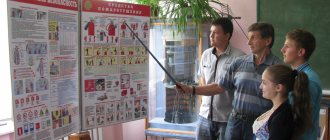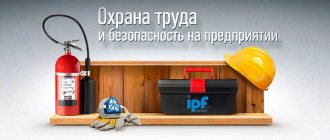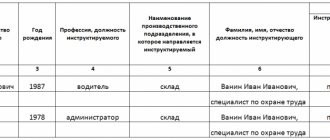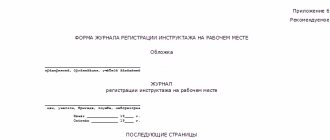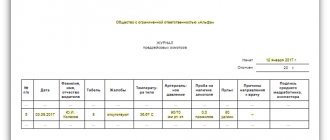https://youtu.be/yeCw92SraN0
Repeated training in the workplace - what is it?
On-the-job refresher training program
What is the frequency of refresher training at the workplace?
Who should undergo refresher training?
Do all employees need to undergo refresher training?
Who is entrusted with conducting repeated training at the workplace?
Refresher training for remote workers and homeworkers
Conducting refresher training for contractors
Oral check and log book
Training for managers and specialists
Results
Repeated training in the workplace - what is it?
Repeated briefing at the workplace is one of the 5 types of mandatory safety briefings (HS), provided for by Decree of the Ministry of Labor and Ministry of Education of the Russian Federation dated January 13, 2003 No. 1/29 (hereinafter referred to as the Training Procedure).
Briefing is a way of briefly informing employees about hazardous production factors, general rules for providing first aid and practical skills that must be possessed in order not to cause harm to life and health during work.
Repeated briefing is intended to maintain and update knowledge on TB acquired during other types of training, therefore, unlike other types of briefing (introductory, targeted, unscheduled and primary), it is carried out on a regular basis.
You can learn everything about induction training from the article “How is induction training conducted on labor protection?”
Repeated training on labor protection: frequency
This article contains information about repeated briefings on labor protection: frequency, volume and timing of their implementation, who should and should not undergo them, answers to frequently asked questions about this type of briefing.
Instructions on occupational safety in organizations are carried out to ensure that workers promptly:
— became familiar with the inherent dangers and hazards of specific production processes and workplaces; — have mastered or refreshed their memory of safe work practices and safety requirements; — demonstrated sufficient knowledge of regulatory, operational, technical documentation, quality skills and safe work skills for safe work.
Therefore, re-instruction is an integral part of any production process. Its main goal is to maintain workers’ occupational safety knowledge, skills and safe work habits at a level sufficient to maintain health and performance. The main difference between this type of instruction is the absence of other reasons for conducting it, other than the onset of the deadline established by regulatory documentation.
″ Repeated instructions are carried out at least once every 6 months. This frequency of repeated training on labor protection does not mean that it cannot be carried out more often than once every six months.
At the employer's discretion, repeated instructions for certain categories of workers can be organized, for example, quarterly.
On-the-job refresher training program
All TB trainings are carried out according to special programs.
Retraining programs are developed by heads of departments (shops, sections, departments). After agreement with the persons or structures responsible for labor protection, they are approved and put into effect by order of the enterprise. When developing the program, legislative acts, instructions, industry standards, and technical working documentation are taken as a basis.
The main issues that should be covered are contained in GOST 12.0.004-90 “Organization of occupational safety training.”
The retraining program must be structured in such a way that the following information is communicated to the employee during the training process:
- general information about the production process and the equipment to be used;
- list of factors harmful to health;
- rules for safe stay and movement on the territory of the enterprise;
- rules for preparing equipment and inventory;
- information about hazardous areas near equipment and machinery;
- information about available automatic protection systems (such as blocking, alarms, braking), personal protective equipment, rules for their use;
- rules of behavior in dangerous situations;
- statistics and analysis of industrial accidents.
You will learn what harmful factors there are in production from the article “Dangerous and harmful production factors (list).”
What program?
Any process related to the provision of behavioral instructions must follow a specific program.
Its development is the task of the head of the organization or structural unit, and the basis is the program for conducting primary activities.
Next, the plan is agreed upon with the internal labor protection service or a specialized specialist. Finally, the manager approves this with an order and assigns a time frame for implementation.
The program must include issues that are important for the state, for example, these are:
- general information regarding the production process;
- equipment data;
- whether there are harmful conditions;
- rules on how it will be safer to be in the work area and move around it;
- procedure for preparing for work, features of using existing machines and equipment;
- reporting information about hazardous areas;
- informing about the availability of personal or automatic protective equipment, as well as explanations on their use;
- in what order should you act if an emergency occurs;
- carrying out an analysis of accidents that may have occurred at the enterprise due to ignoring safety precautions.
What is the frequency of refresher training at the workplace?
Repeated training at the workplace is carried out no less than 6 months after the employee has completed the initial training and started work.
In the future, this type of training must be repeated every six months. This is a general rule. The employer does not have the right to arbitrarily increase the time interval between briefings. This is possible only in agreement with the trade union organization or federal and regional bodies that control labor protection issues (clause 7.3.1 GOST 12.0.004-90). A smaller interval is allowed.
For workers employed in complex and hazardous industries, industry rules establish a standard of not six months, but 3 months.
Repeated training on labor protection: frequency and content
Repeated instruction is carried out at least once every 6 months. This frequency of repeated training on labor protection does not mean that it cannot be carried out more often than once every six months. At the employer's discretion, repeated instructions for certain categories of workers can be organized, for example, quarterly. Such a decision should be agreed upon with the trade union committee. In this case, the rule “the more the better” does not work. By setting too short a time interval between briefings, the employer risks receiving a formal repeated briefing on labor protection.
If the operating conditions of the organization are such that there is no point in conducting repeated instructions every six months, then, in agreement with the state supervision authorities, the “inter-instruction” period can be increased. In this case, the period for undergoing repeated instruction should not exceed 12 months. This can be done for seasonal work that workers perform in addition to their main duties. For example, if a seller of a small store must clear the porch of snow and ice, repeated instructions on this type of activity can be carried out once a year - at the beginning of winter.
Repeated instruction at the workplace is carried out according to the same program as the initial one. This means that during the repeated briefing on labor protection the following issues should be covered:
— safe working methods; - operations that the worker must perform before starting and finishing work; — features of the design and operation of equipment, instruments, characteristics of materials that are used in the performance of production tasks; — causes of accidents, accidents, accidents that have occurred or may occur in this department, in similar production facilities in other organizations; — working documentation, its requirements, completeness, where you can familiarize yourself with it if necessary; — PPE, other means of protection, fire extinguishing, methods of their use; — safety equipment for devices, machines, mechanisms, tools; — movement patterns around the unit, workplaces, evacuation patterns; — requirements for the maintenance of the workplace: its preparation for the start and completion of work, who and on what grounds can be within its boundaries; - characteristics, features, production factors inherent in specific technological processes, workplaces in which workers will work; — what to do in dangerous situations.
The main tasks that are solved during repeated instruction:
— refresh your knowledge of occupational safety, develop safe work skills, and pay attention to important nuances that may be forgotten; — check the quality of knowledge, skills and abilities, their sufficiency for the safe performance of work; — make notes in the documentation (briefing logs).
Who should undergo refresher training?
Repeated instruction is necessary for those who have completed the initial instruction (clause 2.1.5 of the Training Procedure).
These are newly hired (under fixed-term and open-ended employment contracts) employees, part-time workers, seasonal workers, secondees, student interns, persons hired to work from other organizations, as well as those transferred within the enterprise from one site to another. In general, everyone who participates in the production process works on machines, mechanisms, electrical equipment or deals with raw materials.
Do all employees need to undergo refresher training?
According to clause 2.1.4 of the Training Procedure, employees who do not have to use equipment, electrical and other tools, raw materials, materials, or store them in the course of their work may not undergo initial and repeated briefing.
For the exemption to be legal, the employer must by order approve the preferential list of professions and positions.
This paragraph of the Training Procedure raises the most questions due to the inaccuracy of the wording.
In particular, it is not clear whether it is possible not to conduct periodic briefings for office employees.
The Ministry of Labor of the Russian Federation, answering this question (letter dated March 24, 2015 No. 15-2/OOG-1551), indicated that those who deal exclusively with office equipment may not undergo initial and repeated training.
And then a link is given to clause 2.1 of GOST 12.0.004-90 “System of Occupational Safety Standards”, which says that the employer needs to coordinate the list of exempt people with the trade union organization and the safety service. At the same time, the Training Procedure (clause 2.1.4) does not contain any requirements for approval.
Important! In conditions of legal uncertainty, the employer should understand that by signing an order to exempt employees from undergoing periodic training and being a guarantor of safe work, he signs his full confidence that this workplace cannot pose any threat to life and health.
If an accident occurs at work with one of the office staff, the blame will fall entirely on the employer.
The manager and the organization itself will have to not only pay a fine, but also compensate for moral and material damage to the victim. The head of the enterprise will pay a fine from 15,000 to 25,000 rubles, the organization, as a legal entity, will lose from 110,000 to 130,000 rubles. (Article 5.27 of the Code of Administrative Offenses of the Russian Federation).
Who has exemption
Some categories of people may still be exempt from the need to undergo training, but for this there are clear criteria for granting preference.
There are only two groups, and the first includes citizens who may not go through the primary process in accordance with the law.
If the manager orders, then the second category can include people whose activities are not related to the use and maintenance of existing equipment, work in electrical networks, as well as the storage and use of raw materials and various materials.
For example, this cannot be canceled for electricians, as well as for drivers who must be aware of safety regulations.
Who is entrusted with conducting repeated training at the workplace?
Who should carry out the briefing - personally to the head of the enterprise (individual entrepreneur), heads of workshops, sections, foremen, assigned employees or attracted teachers and specialists, depends on the number of employees.
Important! A mandatory requirement for instructors is to undergo appropriate training and knowledge testing in specialized educational centers.
At enterprises with more than 50 employees, a separate specialist must be appointed or an independent labor protection unit must be organized (Article 217 of the Labor Code of the Russian Federation). The responsibilities of the specialist or unit will include organizing any safety training.
In organizations with a smaller workforce (up to 50 people), the manager can deal with safety issues personally (if he considers it appropriate), he can entrust them to one of the employees, organize an appropriate department or enter into an agreement with an accredited organization that will oversee labor safety issues, including re-training.
The manager must issue an order assigning responsibilities for conducting repeated and initial briefings to specific individuals.
Who is entrusted with the organization?
First of all, you need to understand what retraining is, because the name itself suggests that knowledge is updated and tested after the initial report.
The purpose of this event is to maintain the level of knowledge among employees that was obtained through introductory and primary types of clarification.
Also, responsible persons can check how well their subordinates have mastered the information conveyed, and even issue permission to work based on the results of control.
The purpose of such clarification is to update information that may have been forgotten by employees over a long period, as well as the need to verify its availability.
All stages are recorded in official documents in case of disputes or emergencies.
This way, management is insured in case of unforeseen situations, because documentation will help prove that clarifications were carried out at the proper level.
The reason for the briefings is the requirement of the law, which is specified in GOST number 12.0.004-90, as well as its paragraph 7.3.1.
It is there that it is said that repeated clarifications should be carried out constantly and on the basis of a plan, and not for reasons that arose at the enterprise.
At the same time, the implementation remains on the conscience of the managers, because they must appoint a person responsible for these events.
The person appointed depends entirely on the size of the staff, and this is divided into numbers up to 50 and above that.
If the threshold is exceeded, according to Article 217 of the Labor Code, it is necessary to organize a special service at the enterprise that will conduct activities in the field of labor protection and at the same time, a specialist should also be hired, reflecting this in the staffing table.
Thus, a specialist will be involved in the area, and he will also be responsible for the consequences.
With a staff of less than fifty people, there may be options:
| Optional | You can still organize a labor protection department |
| Supervisor | Can lead meetings and deliver information independently |
| Responsibilities are transferred through internal documentation to one of the employees | Who has undergone special training |
| The right to such activities is transferred to a third party | Has accreditation and the necessary specialists |
Refresher training for remote workers and homeworkers
Telecommuters, like all others, must be trained in workplace safety procedures. It is the employer’s responsibility to conduct initial training before allowing such an employee to work. This means that he is required to undergo repeated training every 6 months.
In this case, the Labor Code of the Russian Federation allows for a remote method of repeated instructions (Part 6 of Article 312.1). You can confirm completion of the training by exchanging electronic documents.
With regard to homeworkers, the requirement to undergo regular six-month training is also fair, since homework is permitted only if labor safety requirements are met (Article 311 of the Labor Code of the Russian Federation). Since repeated instruction is carried out at the workplace, a specialist instructor must travel to the homeworker’s place of work.
Conducting refresher training for contractors
The regulatory documents do not define who should conduct repeated training for the employees of the contracting organization involved - the customer or the contractor. Employees of involved organizations are mentioned only in cases related to induction training (clause 2.1.2 of the Training Procedure).
The conclusion suggests itself that in relation to the attracted workforce, the customer organization is only subject to the obligation to conduct induction training.
The remaining types of training must be carried out by the contracting organization with its employees.
Since the contractor carries out work on the customer’s territory, the latter is obliged to monitor compliance with safety standards at its own site, including repeated training for employees of the contracted organization.
Types of instruction
There are 5 types of instructions in total, they are divided into:
| Type of instruction | Who conducts | Purpose of the event |
| Introductory | The instruction is carried out by a labor protection specialist or an authorized employee. The appointment of the person responsible for instructing workers can be secured by an administrative document, and the instructing person must be certified in occupational safety and health (OHS) | Before entering the enterprise, the employee must listen to a lecture on occupational safety. The material issued takes into account the nuances of being on the territory, possible dangers, the basics of fire safety, first aid, actions in the event of emergencies or incidents. |
| Primary | This type of briefing is carried out by the immediate supervisor to the new employee before the latter starts work. In this case, the conductor must have an occupational health and safety (HS) certificate. | The newcomer, despite having undergone training, must be familiarized with the workplace and the possible dangers of the new job. He is informed of the working hours regulations, at what time lunch or rest breaks are set, as well as possible dangers in the work area. |
| Repeated | Conducted by immediate supervisor | The material of the initial briefing is repeated |
| Unscheduled | Instruction of employees is assigned to the immediate supervisor | This type of instruction is carried out in the following cases:
|
| Target | The manager instructs the workers | If an employee is sent to perform a task that is unusual for his job description or to perform dangerous work, then he must be instructed in accordance with the current instructions, and it should be taken into account that the performance of dangerous tasks requires the presence of a certificate |
Instructions are mandatory and regulated by GOST.
Oral check and log book
Employees should not only be passive listeners, but also undergo an oral test of acquired knowledge after each briefing. Those who showed unsatisfactory results are not allowed to work and are required to undergo instructions and testing again (clause 7.8 of GOST 12.0.004-90).
Data on the briefing must be recorded in the registration log (Appendices 4 and 6 to GOST 12.0.004-90) with the signatures of those who conducted the briefing and who listened to it.
Employees who did not undergo training on time, regardless of whether this happened for a good reason (being on sick leave) or not, cannot be allowed to work.
Training for managers and specialists
Managers of enterprises and specialists in occupational safety and health are not instructed, but trained (part 2 of article 225 of the Labor Code of the Russian Federation, clause 1.5 of the Training Procedure). This more in-depth, compared to briefing, method of acquiring knowledge is mandatory for those who are responsible for safety at the entrusted enterprise and who themselves will train ordinary employees (part 2 of article 225 of the Labor Code of the Russian Federation, clause 1.5 of the Training Procedure).
Once employed, directors of enterprises, specialists and heads of safety departments must undergo training at an accredited training organization. They were given 1 month for this. Subsequently, retraining is required every 3 years.
An exception is made for occupational safety teachers with 5 years or more of continuous work experience, safety engineers and representatives of supervisory authorities at the federal and regional levels.
These categories of specialists can undergo training for the first time after employment not 1 month, but 1 year (clause 1.6 of the Training Procedure). They are required to undergo further regular training every 3 years.
Results
Repeated training in the workplace is an opportunity to maintain and update knowledge of safe work rules.
Almost all employees must undergo it at least 2 times a year. The employer is obliged to organize the process, and employees are obliged to undergo training, acquire knowledge and apply it in practice. You can find more complete information on the topic in ConsultantPlus. Full and free access to the system for 2 days.

